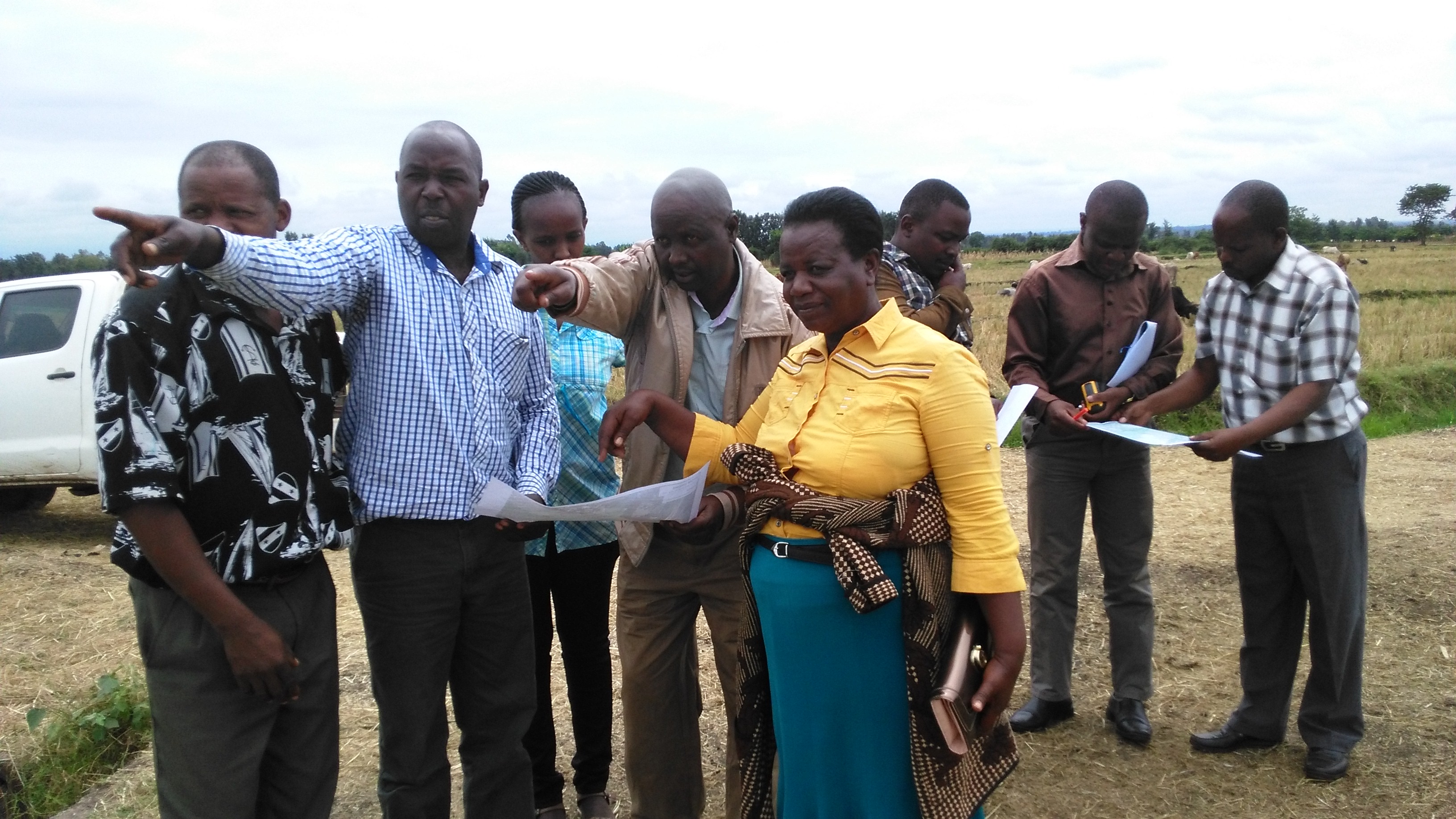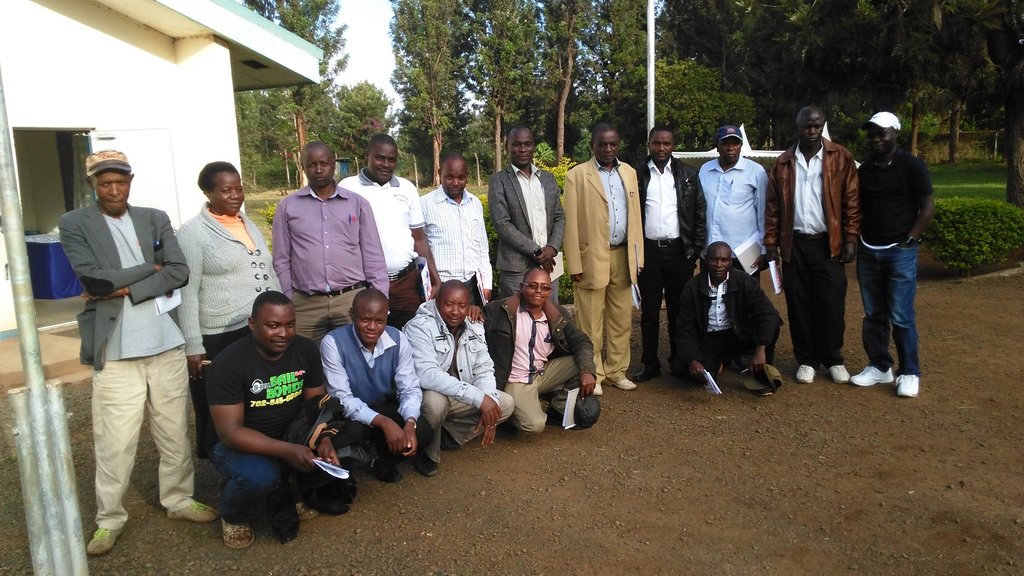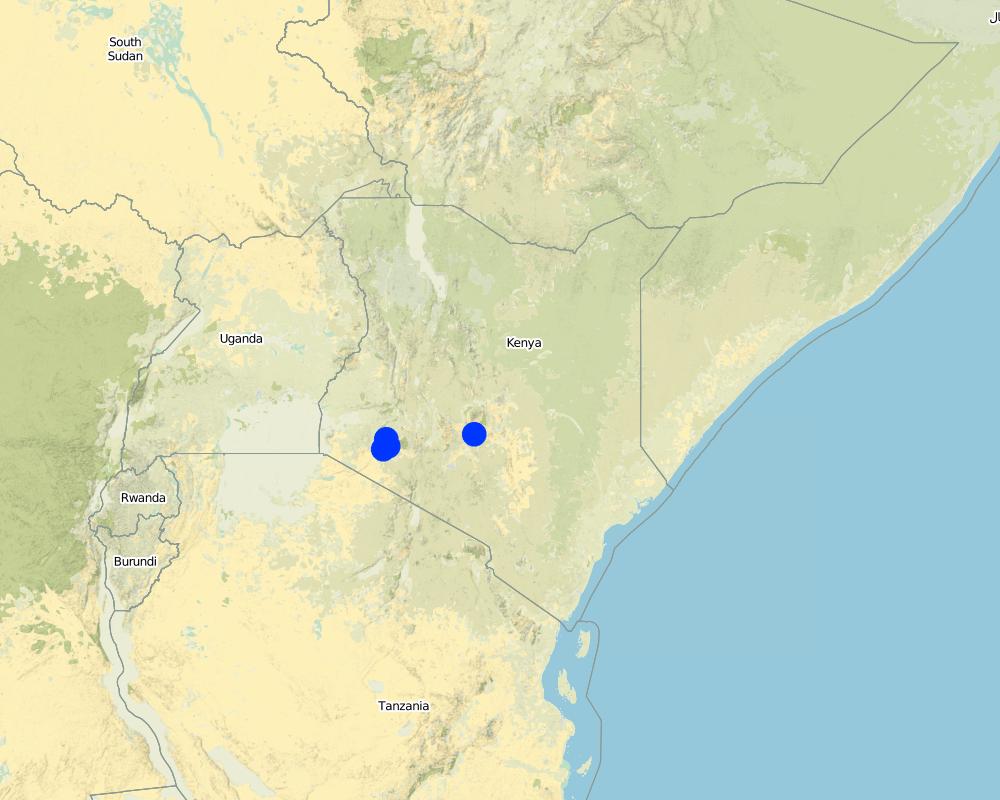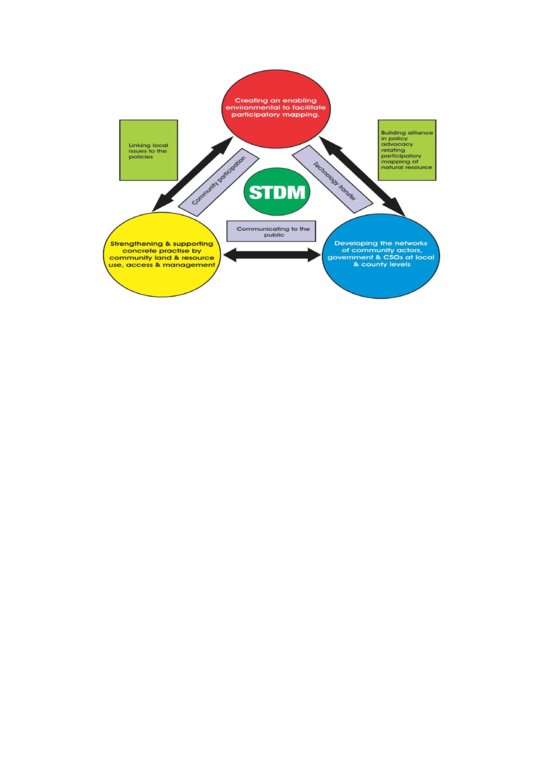Participatory Community Resource Mapping using Social Tenure Domain Model (STDM) [Kenia]
- Creación:
- Actualización:
- Compilador: Ken Otieno
- Editor: –
- Revisor: Rima Mekdaschi Studer
STDM Project
approaches_3379 - Kenia
- Resumen completo en PDF
- Resumen completo en PDF para imprimir
- Resumen completo en el navegador
- Resumen completo (sin formato)
- Participatory Community Resource Mapping using Social Tenure Domain Model (STDM): 5 de marzo de 2018 (inactive)
- Participatory Community Resource Mapping using the Social Tenure Domain Model (STDM): 19 de mayo de 2018 (inactive)
- Participatory Community Resource Mapping using the Social Tenure Domain Model (STDM): 4 de junio de 2018 (inactive)
- Participatory Community Resource Mapping using the Social Tenure Domain Model (STDM): 3 de septiembre de 2018 (public)
Visualizar secciones
Expandir todo Colapsar todos1. Información general
1.2 Detalles de contacto de las personas de referencia e instituciones involucradas en la evaluación y la documentación del Enfoque
Persona(s) de referencia clave/s
Especialista MST:
Nombre de la(s) institución(es) que facilitaron la documentación/ evaluación del Enfoque si fuera relevante)
Resource Conflict Institute (RECONCILE) - Kenia1.3 Condiciones referidas al uso de datos documentados mediante WOCAT
¿Cuándo se compilaron los datos (en el campo)?
04/09/2017
El compilador y la/s persona(s) de referencia claves aceptan las condiciones acerca del uso de los datos documentados mediante WOCAT :
Sí
2. Descripción del Enfoque MST
2.1 Breve descripción del Enfoque
Social Tenure Domain Model (STDM) is about people and their relationships with land. The tool as applied secures tenure through the recognition of tenure diversity and social contexts. STDM recognizes that secure tenure builds confidence among the resource users and therefore promotes investments confidence at different levels including; small scale, large scale both urban and rural investors who all need secure tenure.
2.2 Descripción detallada del Enfoque MST
Descripción detallada del Enfoque MST:
The Rangelands Initiative Africa is a programme of the International Land Coalition (ILC) that is working to make rangelands more tenure secure. Resource Conflict Institute (RECONCILE) hosts and coordinates the Africa component while ILRI hosts and coordinates the Global component. Rangelands Initiatives existence recognizes that rangelands diverse resources and interests transcends across different stakeholders and therefore learning within these groups is important for strategic interventions and responses.
RECONCILE seeks to demonstrate the application the Social Tenure Domain Model (STDM) in a rural setting has been able to secure social tenure rights for increased production among smallholder farmers. This land management and tenure security programme sought to address the dynamics around common resources in Bomet. Recognizing that there are multiple claims to common resources; the technology uses the people as the central nexus in land administration. As such, an extensive range of systems and processes to manage land through effective and accurate planning and management.
Land as a factor of production attracts interests from stakeholders. As such, secure access to land, whether through formal, informal, customary or other means, is necessary for rural households to enjoy sustainable livelihoods, and is an important part of sustainable development. Securing access by rural poor people to land and water rights is key to the reduction of extreme poverty and hunger, since land and water are among the most important assets that poor rural women, youths and men have. Kenya has legal, policy and institutional frameworks and governance systems that presents options and opportunities.
STDM process involves, problem identification, stakeholder analysis, training, community enumeration, data collection both socio-economic and spatial data and total data management. The process allows an understanding and testing the extent STDM technology responded to gaps and how best they could be applied to cater for needs of all stakeholders within the rural, agricultural, communal land settings. The application of the technology demands complete data sets that are consolidated through total census of both resources users and resources.
2.3 Fotos del Enfoque
2.5 País/ región/ lugares donde el Enfoque fue aplicado
País:
Kenia
Región/ Estado/ Provincia:
Bomet county
Especifique más el lugar :
Kembu sub-county
Comentarios:
The project implementation was done in three counties two of which the actual approach applied these are Bomet and Kirinya.
Map
×2.6 Fechas de inicio y conclusión del Enfoque
Indique año del inicio:
2016
Si no se conoce el año preciso, indique la fecha aproximada en la que se inició el Enfoque:
hace menos de 10 años (recientemente)
Año de conclusión (si el Enfoque ya no se aplica):
2017
Comentarios:
Even though the project ended with the contract with the UNHABITAT, RECONCILE is still progressing with the approach in other areas
2.7 Tipo de Enfoque
- proyecto/ basado en un programa
2.8 Propósitos/ objetivos principales del Enfoque
- Improve production
- Reduce, prevent, restore land degradation
- Conserve ecosystem
- Protect a watershed/ downstream areas
2.9 Condiciones que facilitan o impiden la implementación de la/s Tecnología/s aplicadas bajo el Enfoque
normas y valores sociales/ culturales/ religiosos
- facilitan
The approach is participatory and the communities consent to the process taking leadership as such it is an enabler.
disponibilidad/ acceso a recursos y servicios financieros
- facilitan
Based on secure tenure rights by way of confidence building, the communities as individual investors increase their investment and as a result increased income
entorno institucional
- facilitan
The approach is engaging and therefore flexible to inclusion of different institutions including government and private
colaboración/ coordinación de actores
- facilitan
Promotes partnership and collaboration
marco de trabajo legal (tenencia de tierra, derechos de uso de tierra y agua)
- facilitan
Strengthens such frameworks as participatory resource securing process that reinforces accountability and services delivery. It recognizes the multiple tenure and resource rights
políticas
- facilitan
The STDM process is compatible with diverse policy frameworks that supports the use and management of communal resources.
gobernanza de tierras (toma de decisiones, implementación y aplicación)
- impiden
In circumstances where land governance is not well defined, the process posses challenges and sometimes expectations and or lack of it undermines the process
3. Participación y roles de las partes interesadas involucradas
3.1 Partes interesadas involucradas en el Enfoque y sus roles
- usuarios locales de tierras/ comunidades locales
Small holder dairy farmers.
These farmers and community members were the key players in data collection, were the users of the approach and technology.
- especialistas MST/consejeros agrícolas
GIS specialists, Lawyers, development experts.
Provided skills and expertise.
- ONG
Technical University of Kenya, Regional Centre for Mapping Resources for Development, Pamoja Trust.
All these institutions had a role in the project based on their previous engagement with UNHABITAT.
Si varias partes interesadas estuvieron involucradas, indique la agencia principal:
RECONCILE was the lead
3.2 Involucramiento de los usuarios locales de tierras/ comunidades locales en las distintas fases del Enfoque
| Involucramiento de los usuarios locales de tierras/ comunidades locales | Especifique quién se involucró y describa las actividades | |
|---|---|---|
| iniciación/ motivación | interactivo | The communities internalized the process and as such were very engaging and even self mobilized for the tasks |
| planificación | interactivo | Same as above |
| implementación | interactivo | These were the key people in all the process of resource identification mapping and protection of both communal and private resources identified and mapped. |
| monitoreo y evaluación | auto-movilización | They still follow and report on status |
3.3 Flujograma (si estuviera disponible)
Descripción:
Using technology to enhance production among farmers need well thought approaches -Recognize diverse dynamics -Manage expectations
Autor:
Ken Otieno
3.4 La toma de decisiones en la selección de Tecnología(s) MST
Especifique quién decidió la selección de las Tecnología/ Tecnologías a implementarse:
- todos los actores relevantes, como parte de un enfoque participativo
Especifique las bases que sustentaron la toma de decisiones:
- hallazgos de investigaciones
4. Apoyo técnico, fortalecimiento institucional y gestión del conocimiento
4.1 Construcción de capacidades / capacitación
¿Se proporcionó la capacitación a usuarios de tierras/ otras partes interesadas?
Sí
Especifique quién fue capacitado:
- usuarios de tierras
- personal de campo/ consejeros
Forma de capacitación:
- en el contexto de trabajo
- de agricultor a agricultor
- reuniones públicas
4.2 Servicio de asesoría
¿Los usuarios de tierras tienen acceso a un servicio de asesoría?
Sí
Especifique si servicio proporcionado se realizó:
- en los campos de los usuarios de tierras
- en centros permanentes
Describa/ comentarios:
The users are beneficiaries of a government programme in the areas and were the basis against which the approach was used to close the gap.
4.3 Fortalecimiento institucional (desarrollo institucional)
¿Se establecieron o fortalecieron instituciones mediante el Enfoque?
- sí, mucho
Especifique el nivel o los niveles en los que se fortalecieron o establecieron las instituciones:
- local
Especifique el tipo de apoyo:
- construcción de capacidades/ entrenamiento
- equipo
4.4 Monitoreo y evaluación
¿El monitoreo y la evaluación forman parte del Enfoque?
Sí
Si respondió que sí, ¿la documentación se utilizará para monitoreo y evaluación?
No
4.5 Investigación
¿La investigación formó parte del Enfoque?
No
5. Financiamiento y apoyo material externo
5.1 Presupuesto anual para el componente MST del Enfoque
Si no se conoce el presupuesto anual preciso, indique el rango:
- 10,000-100,000
5.2 Apoyo financiero/material proporcionado a los usuarios de tierras
¿Los usuarios de tierras recibieron financiamiento/ apoyo material para implementar la Tecnología/ Tecnologías? :
No
5.3 Subsidios para insumos específicos (incluyendo mano de obra)
- ninguno
Si la mano de obra de usuarios de tierras fue un insumo sustancial, ¿fue:
- voluntario?
5.4 Crédito
¿Se proporcionó crédito bajo el Enfoque para actividades MST?
No
5.5 Otros incentivos o instrumentos
¿Se usaron otros incentivos o instrumentos para promover la implementación de Tecnologías MST?
No
6. Análisis de impacto y comentarios de conclusión
6.1 Impactos del Enfoque
¿El Enfoque empoderó a los usuarios locales de tierras, mejoró el involucramiento de las partes interesadas?
- No
- Sí, un poco
- Sí, moderadamente
- Sí, mucho
Communities and the programme benefited and revamped the resource management committees.
¿El Enfoque facilitó la toma de decisiones basada en evidencia?
- No
- Sí, un poco
- Sí, moderadamente
- Sí, mucho
The County governments greatly recognizes and appreciates the technology and approach to the extent that they will use the information and date in planning and resources allocation.
¿El Enfoque ayudó a los usuarios de tierras a implementar y mantener Tecnologías MST?
- No
- Sí, un poco
- Sí, moderadamente
- Sí, mucho
Yes, the fact that the programme used local land users as key experts in the actual work has established local resources.
¿El Enfoque mejoró la coordinación e implementación efectiva en costos de MST?
- No
- Sí, un poco
- Sí, moderadamente
- Sí, mucho
The partnership between and among government institutions have increased.
¿El Enfoque movilizó/mejoró el acceso a recursos financieros para implementar MST?
- No
- Sí, un poco
- Sí, moderadamente
- Sí, mucho
The concept of the bigger programme was to support milk bulking and this has been achieved through improved resources use and management which in turn has enhanced milk produce; volume and quality.
¿El Enfoque mejoró el conocimiento y capacidades de los usuarios para implementar MST?
- No
- Sí, un poco
- Sí, moderadamente
- Sí, mucho
To the extent that the community resource users are directly involved in resource use and management, knowledge and skills are enhanced due to exposure and interactive sessions.
¿El Enfoque mejoró el conocimiento y capacidades de otras partes interesadas?
- No
- Sí, un poco
- Sí, moderadamente
- Sí, mucho
The application of skills by local people influenced the thinking.
Partnership and collaborations developed
¿El Enfoque mitigó conflictos?
- No
- Sí, un poco
- Sí, moderadamente
- Sí, mucho
It was not the main thing though.
¿El Enfoque empoderó a grupos en desventaja social y económica?
- No
- Sí, un poco
- Sí, moderadamente
- Sí, mucho
They were not targeted directly but benefited from the wider community scope.
¿El Enfoque mejoró la equidad de género y empoderó a las mujeres y niñas?
- No
- Sí, un poco
- Sí, moderadamente
- Sí, mucho
Both men and women were equally involved in the process.
¿El Enfoque alentó a jóvenes/ la siguiente generación de usuarios de tierras a involucrarse con MST?
- No
- Sí, un poco
- Sí, moderadamente
- Sí, mucho
The use if GPS was and incentive.
¿El Enfoque mejoró cuestiones de tenencia de tierra/ derechos de usuarios que obstaculizaron la implementación de la Tecnologías MST?
- No
- Sí, un poco
- Sí, moderadamente
- Sí, mucho
The approach does not explicitly engage in issues of tenure but, in its implementation awareness is created.
¿El Enfoque resultó en mejor seguridad alimentaria/ mejoró la nutrición?
- No
- Sí, un poco
- Sí, moderadamente
- Sí, mucho
This can be acknowledged to some degree but needs a study on the project impact on nutrition.
¿El Enfoque mejoró el acceso a los mercados?
- No
- Sí, un poco
- Sí, moderadamente
- Sí, mucho
Was not a direct concern but yes, it did based on more milk production.
¿El Enfoque llevó a un acceso mejorado a tierra y saneamiento?
- No
- Sí, un poco
- Sí, moderadamente
- Sí, mucho
Yes clean water.
¿El Enfoque llevó a un uso más sostenible/ fuentes de energía?
- No
- Sí, un poco
- Sí, moderadamente
- Sí, mucho
by enhanced use of bio gas yes.
¿El Enfoque mejoró la capacidad de los usuarios de tierras a adaptarse a los cambios climáticos/ extemos y mitigar desastres relacionados al clima?
- No
- Sí, un poco
- Sí, moderadamente
- Sí, mucho
¿El Enfoque llevó a oportunidades de empleo, ingresos?
- No
- Sí, un poco
- Sí, moderadamente
- Sí, mucho
6.2 Motivación principal del usuario de la tierra para implementar MST
- producción incrementada
6.3 Sostenibilidad de las actividades del Enfoque
¿Pueden los usuarios de tierras sostener lo que se implementó mediante el Enfoque (sin apoyo externo)?
- sí
Si respondió que sí, describa cómo:
The approach application did not attract any material gains or incentives but, the process was community centered thus the adoption.
6.4 Fortalezas/ ventajas del Enfoque
| Fuerzas/ ventajas/ oportunidades desde la perspectiva del usuario de la tierra |
|---|
|
The approach was targeting identified problem that was felt by the actors/ implementer and communities in a joint mission. The approach demonstrated the capability to map livelihood resources of the rangeland users including those resources associated with milk production such as milk coolers, water points, cattle dips, food stores, grazing areas, salt licks, crush, animal corridors, forest e.t.c |
|
Collectively, communities were able to know the status (management) of communal shared resources and responsible persons. Establishment of the Land tenure system of shared communal resources and issues arising. Status (management) of private resources within the rangelands. |
| Fuerzas/ ventajas/ oportunidades desde la perspectiva del compilador o de otra persona de referencia clave |
|---|
| The approach uses participatory approach hence building community ownership. |
|
The mix of the approach bridges the gap through skills transfer and capacity building and in facilitating dialogue on issues affecting the community (Maps, reports). Ensures the adaptability of the process though technical, is simplified users can relate with and find value in their use contributed immense success. |
|
STDM database accommodate inclusion of social economic and spatial data that can be maintained, accessed and update by the communities anytime. Provided visual representation of available resources and their distribution and people can relate to spatial information on the map. |
|
Ownership of technology by local people who are now leading on data collection, customizing the template, developing reports and innovating on its use. |
|
|
6.5 Debilidades/ desventajas del Enfoque y formas de sobreponerse a ellos
| Debilidades/ desventajas/ riesgos desde la perspectiva del usuario de la tierra | ¿Cómo sobreponerse a ellas? |
|---|---|
| The design of the tool was a more urban oriented and took time to be adopted for rural use especially where land is communal and customs are key. | Created more awareness. |
| Debilidades/ desventajas/ riesgos desde la perspectiva del compilador o de otra persona de referencia clave | ¿Cómo sobreponerse a ellas? |
|---|---|
|
Difficult to setup the server environment where no internet is available. Engaging other service providers may be difficult and takes time (Internet service provider need to authorize setting up additional server). Appropriate devices for capturing data may necessity additional budget. |
The internet component remain a challenge. Technology is evolving and needs systematic information channels even with the community members. The process requires proper funding in order not to have a break in between. |
7. Referencias y vínculos
7.1 Métodos/ fuentes de información
- visitas de campo, encuestas de campo
900
- entrevistas con usuarios de tierras
900
- entrevistas con especialistas/ expertos en MST
2
- compilación de informes y otra documentación existente
7.3 Vínculos a la información relevante disponible en línea
Título/ descripción:
RECONCILE end of project report and other progress reports are available for sharing
Título/ descripción:
Food security in Bomet county
URL:
awsc.uonbi.ac.ke/sites/default/files/chss/arts/.../Bomet-final.doc
Vínculos y módulos
Expandir todo Colapsar todosVínculos
No hay vínculos
Módulos
No se hallaron módulos






